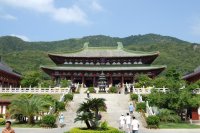06.29.2009
Mount Wutai now officially belongs to UNESCO’s world heritage list. With its five plateaus and its 53 monasteries, this place is sacred for Chinese buddhism. Thus, Mount Wutai is one of the four sacred mountains of buddhism.
Located in Shanxi, Wutai is the place of practice of the Bodhisattva of wisdom. This mountain has an unusual topography consisting in five peaks. Referred as the first among the four great mountains, Wutai’s bodhisattva is believed to frequently manifest himself on the mountain, taking the form of monks, or most often unusual five-colored clouds.
Mount Wutai is extraordinary rich of archeological treasures, such as the oldest wooden buildings in China from the Tang era between the 7th and the 10th century.

The “clear cool mountain” reveals loads of treasure; temples with bronze pagodas, wondeful brick temples. And it’s a place full of legends. For instance, Luo Hou, one of the Bodhisattva Wisdom is said to have danced a “ghost dance” to mark his birthday on the 14th of June. Since then, monks performed a masked dance from dawn to dusk.

The “clear cool mountain” is eventually a main place for chinese buddhism and also for tibetan buddhists, and offer to visitors an astonishing change of scenery.
Thomas PRADO for www.buddhachannel.tv




